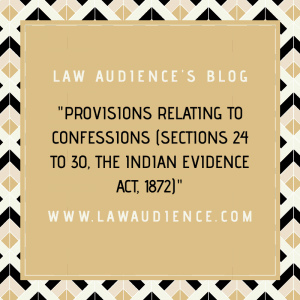AUTHORED BY: MS. NISHITA KAPOOR, B.COM.LL.B, STUDENT AT UNIVERSITY INSTITUTE OF LEGAL STUDIES, PANJAB UNIVERSITY & RESEARCH WRITER AT LAW AUDIENCE.
I. INTRODUCTION:
The Divorce by Mutual Consent has been a very controversial aspect of Hindu Law. There have been various debates regarding the Constitutionality of this aspect of Hindu Law. In simple words, it can be said that divorce by mutual consent is a no faulty divorce. It is defined as a peaceful settlement between the parties to dissolve the marriage. Earlier this form of divorce was not recognized under the Hindu Law. Section 13B, of the Hindu Marriage Act, 1955, and Section 28 of the Special Marriage Act, 1954, was introduced in the respective Acts to recognise this concept of Divorce by Mutual Consent. The Divorce by Mutual Consent is regarded as the fastest mode of getting a divorce in India.
II. PROVISION UNDER THE HINDU MARRIAGE ACT:
Under the Hindu Marriage Act, this provision was inserted by the Amendment Act No. 68 of 1976. The provision is as follows:
(1) Subject to the provisions of this Act a petition for dissolution of marriage by a decree of divorce may be presented to the district court by both the parties to a marriage together, whether such marriage was solemnized before or after the commencement of the Marriage Laws (Amendment) Act, 1976 (68 of 1976), on the ground that they have been living separately for a period of one year or more, that they have not been able to live together and that they have mutually agreed that the marriage should be dissolved.
(2) On the motion of both the parties made not earlier than six months after the date of the presentation of the petition referred to in sub-section (1) and not later than eighteen months after the said date, if the petition is not withdrawn in the meantime, the court shall, on being satisfied, after hearing the parties and after making such inquiry as it thinks fit, that a marriage has been solemnized and that the averments in the petition are true, pass a decree of divorce declaring the marriage to be dissolved with effect from the date of the decree.
III. THE CONSTITUTIONALITY OF SEC 13B:
The constitutionality of Section 13B was upheld in the case of Miten v. Union of India[1], it was held that it does not affect the mandate of equality before the law or equal protection of law just because a statute causes hardship it cannot be held to be ultra vires.
IV. ESSENTIALS OF DIVORCE BY MUTUAL CONSENT:
The essentials of the Divorce by Mutual Consent are:
a) The Petition To Be Presented By Both The Parties Together:
It is required for the divorce by mutual consent that the petition has to be jointly presented by both the parties and not solely by one party. The court can only proceed further if both the parties want that their marriage should be dissolved, that is there should be a consensus between the parties.
b) Grounds To Be Mentioned In The Petition:
The petition must clearly mention that the parties have been living separately for a period of one year or more before the presentation of the petition and they are not able to live with each other. The Separation may be consensual or compulsory.[2] There may be cases where the parties had to live under the same roof and yet can be said to be living separately because of the want of the consummation of the matrimonial relations.[3]
It was held in the case of Sureshta Devi v. Om Prakash[4], that the expression “Living Separately” means not living like a husband and wife and has no reference to the place of living. Therefore, what is required to be considered is that the parties have no desire to perform the marital obligations.
In Leela Joshi v. Mahadeo[5] it was held that the term “Living Separately” will have to be read in conjunction with “not having been able to live together”. It is the duty of the court to find out from the averments in the plaint and from the oral evidences that whether the parties have been living separately because of the breakdown of the marital relations or for any other reason.
c) Motion To Be Moved By Both The Parties:
The parties are required to apply to the court not earlier than six months and not later than 18 months from the date of the presentation of the petition. The parties will introduce a joint motion in the court and then the court can grant a decree of divorce only on being satisfied that the marriage had been solemnized and the averments made in the petition are true.
The object behind requiring the parties to move a second motion is that the parties should reconsider their wish to get divorced and should give more time to their relationship as the dissolution of their marriage will have serious consequences for parties as well as for the children. The legislature has provided time to the parties with the object of giving an opportunity to the parties to harmonize their lives rather than to destroy the institution of marriage. The period allowed for moving the second motion is known as “Cooling Period”.
Consent once given can be withdrawn and the consent is not treated as irrevocable.[6] In the case of Suman v. Surendra Kumar[7], it was held that silence at the second stage cannot be taken to amount to a withdrawal of consent. A person has to do some positive act to withdraw his consent otherwise an inference could be drawn that his consent which was initially given is continuing. The consent can be withdrawn at any time before the passing of the decree even after the expiry of the period of 18 months from the date of the presentation of the petition.[8]
V. JUDICIAL STANCE ON REQUIREMENT OF COOLING PERIOD FOR MUTUAL CONSENT:
In the case of Anil Kumar Jain v. Maya Jain[9] it was held that the Supreme Court in the exercise of its extraordinary powers under Article 142 of the Constitution can grant the divorce to the parties even without waiting for a period of six months which is provided under Section 13B of the Hindu Marriage Act, 1955 in the interests of justice when the marriage has irretrievably broken down. It was further held that neither the High Court nor any civil court could pass orders before the expiry of the period mentioned in the provision of Section 13B of the Act.
But the Supreme Court in the case of Amardeep Singh v. Harveen Kaur[10] held that the parties can make a waiver application after one week of moving the first motion to waive the statutory period mentioned in Section 13B when:
- The statutory period of six months in addition to the statutory period of one year as required under Section 13B(1) is already over before the first motion.
- Further waiting period will only prolong their agony
- All efforts for mediation and reconciliation have been tried and have resulted in its failure.
- The issues relating to alimony, custody of children or others have been settled between the parties.
The court thus held that the period under Section 13B is directory and not mandatory but the court has to exercise its discretion having regard to the facts and circumstances of each case and this power can be exercised not only by Supreme Court but by any court dealing with an application under Section 13B.
VI. APPEAL AGAINST DECREE OF MUTUAL CONSENT:
Section 28[11] of the Hindu Marriage Act, deals with the appeal against the decrees passed in any proceeding under the Act and has not expressly laid any bar on the decree of mutual consent.
In the case of Charanjit Singh Mann v. Neelam Mann[12], it was held that appeal is maintainable under Section 28 of the Act against the decree of mutual consent.
In the case of Pooja v. Vijay Chaitanya [13], it has been held that normally there can be no appeal against a consent decree but where the consent itself is in issue and inquiry of the genuineness of the consent has not been made by the court below, then such appeal is maintainable.
VII. CONCLUSION:
One of the most important benefits of opting for the mutual divorce is that there is no wastage of time and financial resources. It saves the parties from mental stress that they face in the ordinary cases of divorce, where there are counter allegations on each other. This is the most peaceful and easiest way of putting an end to the marriage. The recent judicial trend of the courts is very liberal in relation to the marriages where both the parties are willing to get divorced and where the marriage has irretrievably broken down as there is no point in stretching the relation between the incompatible and unhappy couples.
[1] Writ petition no. 2412 of 2007 (India).
[2] Kirtibhai Girdharbhai Patel v. Prafulaben Kirtibhai Patel, A.I.R. 1993 Guj 111 (India).
[3] A.I.R. 2007 Raj 78 (India).
[4] A.I.R. 1992 S.C. 1904 (India)
[5] A.I.R. 1991 Bom 105 (India).
[6] Sureshta Devi v. Om Prakash, A.I.R. 1992 S.C. 1904s (India).
[7] A.I.R. 2003 Raj 155 (India).
[8] Hitesh Bhatnagar v. Deepa Bhatnagar, A.I.R. 2011 S.C. 1637 (India).
[9] CIVIL APPEAL NO. 5952 OF 2009 (India).
[10] CIVIL APPEAL NO 11158 OF 2017 (India).
[11] Section 28 Appeals from decrees and orders:
(1) All decrees made by the court in any proceeding under this Act shall, subject to the provisions of sub-section (3), be appealable as decrees of the court made in the exercise of its original civil jurisdiction, and every such appeal shall lie to the court to which appeals ordinarily lie from the decisions of the court given in exercise of its original civil jurisdiction.
(2) Orders made by the court in any proceeding under this Act under section 25 or section 26 shall, subject to the provisions of sub-section (3), be appealable if they are not interim orders, and every such appeal shall lie to the court to which appeals ordinarily lie from the decisions of the court given in exercise of its original civil jurisdiction.
(3) There shall be no appeal under this section on the subject of costs only.
(4) Every appeal under this section shall be preferred within a 60 [period of ninety days] from the date of the decree or order.
[12] A.I.R. 2006 P&H 201 (India).
[13] 2018 S.C.C. Online All 513 (India).



